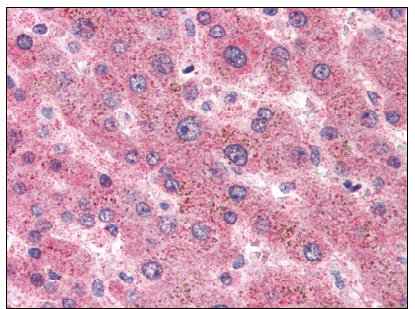Serum Amyloid A (SAA1) Mouse Monoclonal Antibody [Clone ID: n.n]
CAT#: AM20266PU-N
Serum Amyloid A (SAA1) mouse monoclonal antibody, clone n.n, Aff - Purified
Other products for "SAA1"
Specifications
| Product Data | |
| Clone Name | n.n |
| Applications | ELISA, IHC, WB |
| Recommended Dilution | ELISA. Immunohistochemistry on Paraffin Sections: 5 µg/ml. SwELISA. Western Blot. |
| Reactivities | Human |
| Host | Mouse |
| Isotype | IgG2a |
| Clonality | Monoclonal |
| Immunogen | Highly purified recombinant Human SAA 12kD |
| Specificity | Reacts with natural and recombinant Human SAA. Does not show any cross-reactivity with other Human Cytokines or Growth Factors tested such as IL-1B, IL-8, MCAF, TGF-B and EGF. |
| Formulation | PBS, pH 7.2 State: Aff - Purified State: Liquid purified Ig fraction |
| Concentration | lot specific |
| Purification | Protein G Chromatography |
| Conjugation | Unconjugated |
| Storage | Store undiluted at 2-8°C for one month or (in aliquots) at -20°C for longer. Avoid repeated freezing and thawing. |
| Stability | Shelf life: one year from despatch. |
| Gene Name | Homo sapiens serum amyloid A1 (SAA1), transcript variant 1 |
| Database Link | |
| Background | The Serum Amyloid A (SAA) family comprises a number of differentially expressed lipoproteins, acute phase SAA1 and SAA2, the former being a major component in plasma, and constitutive SAA's (C-SAAs). Although the liver is the primary site of synthesis of both SAA types, extrhepatic production has been reported. The in vivo concentrations increase by as much as 1000 fold during inflammation. Several studies have expressed it's importance in the diagnosis and monitoring of various diseases. Pathological SAA values are often detected in association with normal CRP concentrations. SAA rises earlier and more sharply than CRP. SAA enhances the binding of HDL's to macrophages and thus helps the delivery of lipid to sites of injury for use in tissue repair. It is thus thought to be an integral part of the disease process. In addition, recent experiments suggest that SAA may play a "houekeeping" role in normal human tissues. Elevated levels of SAA over time predispose secondary amyloidosis, extracellular accumulation of amyloid fibrils, derived from a circulating precursor, in various tissues and organs. The most common form of amyloidosis occurs secondary to chronic inflammatory disease, particularly rheumatoid artheritis. |
| Synonyms | SAA1, SAA2 |
| Reference Data | |
Documents
| Product Manuals |
| FAQs |
{0} Product Review(s)
0 Product Review(s)
Submit review
Be the first one to submit a review
Product Citations
*Delivery time may vary from web posted schedule. Occasional delays may occur due to unforeseen
complexities in the preparation of your product. International customers may expect an additional 1-2 weeks
in shipping.






























































































































































































































































 Germany
Germany
 Japan
Japan
 United Kingdom
United Kingdom
 China
China



